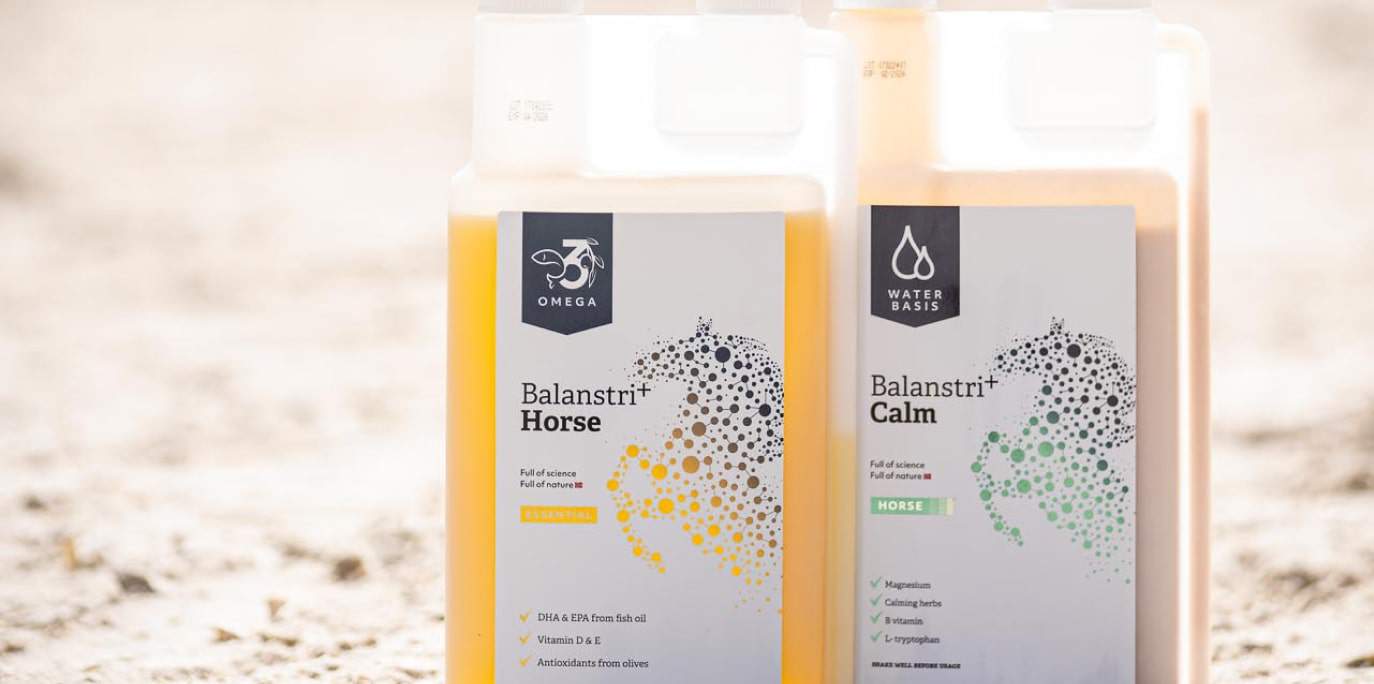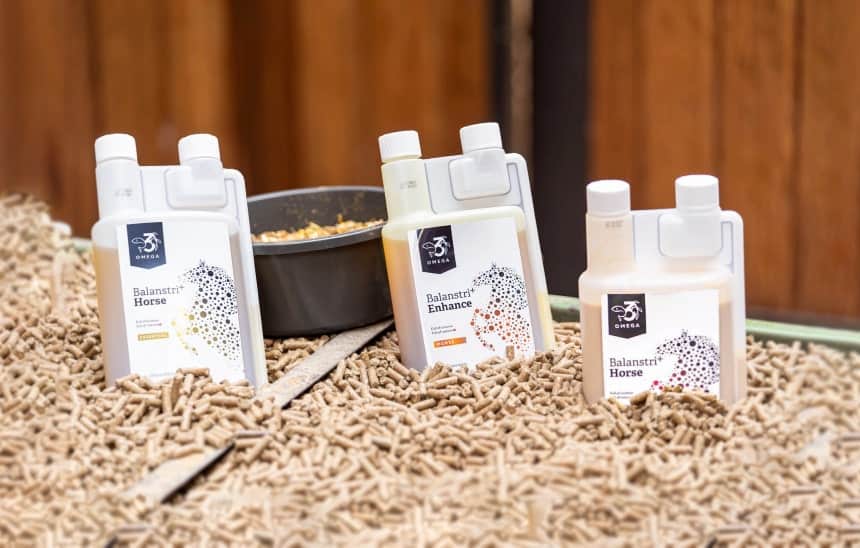

The composition of the 11 fatty acids jointly influence the flexibility of cell membranes, a condition that is essential for active, healthy animals. Flexible blood cell membranes are needed to bring blood to all parts of the animal body, since the diameter of a blood cell is comparable to the diameter of the smallest capillary blood vessels. Stiff blood cells may not penetrate the capillaries, and the animal may not get the blood to all parts needed for optimal performance.
The inflammatory climate influences both acute and chronic conditions. The inflammatory climate is characterized by the composition of polyunsaturated long chain fatty acids (>= 20 carbon atoms in the fatty acids chain) of the Omega-6 type (C20:3 + C20:4) and Omega-3 type (C20:5 + C22:5 + C22:6). These fatty acids are all measured by the Balanstri dried blood spot (DBS) test.
The Balanstri Health Concept guidelines are consistent with the principle of “Safe Feed forAnimals”. The composition of Balanstri oil does not induce changes in lipid peroxidation in the animal body, which might raise concern in relation to cardiovascular disease (CVD) risk, as well as other chronic conditions.
The composition of the 11 fatty acids jointly influence the flexibility of cell membranes, a condition that is essential for active, healthy animals. Flexible blood cell membranes are needed to bring blood to all parts of the animal body, since the diameter of a blood cell is comparable to the diameter of the smallest capillary blood vessels. Stiff blood cells may not penetrate the capillaries, and the animal may not get the blood to all parts needed for optimal performance.
The inflammatory climate influences both acute and chronic conditions. The inflammatory climate is characterized by the composition of polyunsaturated long chain fatty acids (>= 20 carbon atoms in the fatty acids chain) of the Omega-6 type (C20:3 + C20:4) and Omega-3 type (C20:5 + C22:5 + C22:6). These fatty acids are all measured by the Balanstri dried blood spot (DBS) test.
The Balanstri Health Concept guidelines are consistent with the principle of “Safe Feed forAnimals”. The composition of Balanstri oil does not induce changes in lipid peroxidation in the animal body, which might raise concern in relation to cardiovascular disease (CVD) risk, as well as other chronic conditions.
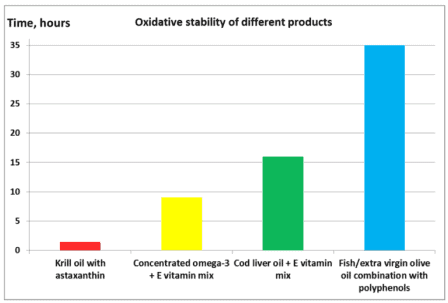
The fatty acid composition of blood cell membranes is in equilibrium with the fatty acid composition of whole blood. In cell membranes saturated- (SAFA) and monounsaturated fatty acids (MUFA) provide stiffness due to the shape of these fatty acids, while polyunsaturated fatty acids (PUFA) provide flexibility.
Long chain omega-3 PUFA (LC- omega-3) and long chain omega-6 PUFA (LC- omega-6) are important structural components of cell membranes and contribute to various membrane functions such as fluidity, permeability, activity of membrane-bound enzymes and receptors, and signal transduction.
The sources of LC-omega- 3 and LC-omega-6 are essential and must be supplied through the diet. A normal diet provides a surplus of both LC-omega-6, SAFA and MUFA. These components shape the cell membrane functionality when LC-omega-3 is depleted. The food supplement Balanstri provides LC-omega- 3 to a normal diet, increasing the LC-omega-3 in blood. Finding a new equilibrium with the fatty acid composition of the whole blood, many of the SAFA and MUFA in cell membranes will be substituted by LC-omega-3 making the cell membrane more flexible and functional.
Table 2 and Figure 2 show that Balanstri added to the diet is effective in reducing the ratio between (SAFA + MUFA) and LC-omega-3 in whole blood independent of breed, providing flexibility and functionality to cell membranes. The data also shows that horses with reported physical problems have an elevated ratio between (SAFA + MUFA) and LC-omega-3 in whole blood. The exception being the Shetland pony Swift, who’s problem may arise from othercauses than fat metabolism.

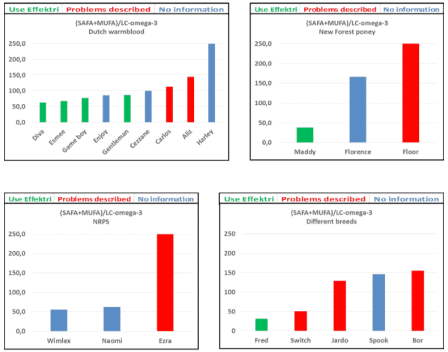
The key link between diet, inflammation and eicosanoids is that the pro-inflammatory eicosanoids are derived from Arachidonic acid (AA), an essential LC-omega-6 fatty acid originating from plants, and the anti-inflammatory eicosanoids that are generated from Eicosapentanoic acid (EPA), an essential LC-omega-3 fatty acid originating mainly from marine sources. Normal diets are often pro-inflammatory containing more Omega-6 than Omega-3, and should be balanced by increased intake of anti-inflammatory LC-omega-3. The % LC- omega-6 of total LC-PUFA (LC-omega-3 + LC-omega-6) in whole blood provides a picture of the pro-inflammatory status of the diet.
Table 3 and Figure 3 show that Balanstri added to the diet is effective in reducing the % LC- omega-6 of total LC-PUFA in whole blood independent of breed, thus reducing the dietary pro- inflammatory climate. The data also shows that most horses with reported physical problems have an elevated dietary pro-inflammatory climate in the whole blood. The exception beingthe Shetland pony Swift, who’s problem may arise from other causes than fat metabolism.

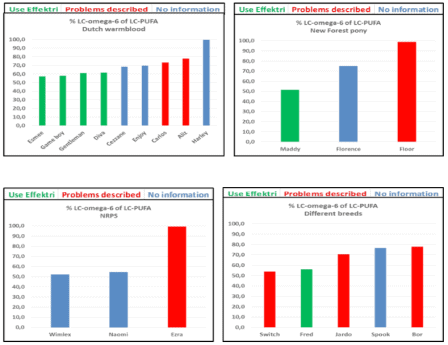
To reduce, restore or maintain the dietary and pro-inflammatory indicators of fat metabolism, our Balanstri oil recommendation is primarily based on the body weight of the horse, adjusted for 1) Exercise level, 2) Condition, 3) Known chronic lifestyle ailments, 4) Dietary indicator result and 5) Pro-inflammatory indicator result.
A basic daily intake of Balanstri oil of 0.05 ml oil per kg body weight (= 25 ml for a 500 kg horse), provides 0.01 g LC-Omega-3 (EPA+DHA) per kg body weight from fish oil (= 5 g LC-Omega-3 for a 500 kg horse). The LC-Omega-3 are protected by 0.02 mg polyphenols from olive oil per kg body weight (= 10 mg polyphenols for a 500 kg horse).
Table 4 provides the ml Balanstri oil recommendations for each of the 20 horses in our example. After treatment as recommended for 120 days, a new test may indicate improvements that may lead to reduced recommended daily maintenance intake of Balanstri for life.

SINTEF – Fisheries and Aquaculture – August 2010. Oil stability index, AOCS Official Method Cd12b-92, average of 3 analysis at 70°C
The scientific opinion of the European Food Safety Authority (EFSA) scientific panel. Protection of blood lipids from oxidative stress. EFSA Journal 2011;9(4):2033)
George E. Billman, Jing X. Kang and Alexander Leaf, 1999. Prevention of Sudden Cardiac Death by Dietary Pure omega-3 Polyunsaturated Fatty Acids in Dogs. Circulation, 1999;99:2452-2457
C.E. Lenox and J.E. Bauer. 2013. Potential Adverse Effects of Omega-3 Fatty Acids in Dogs and Cats. J Vet Intern Med 2013;27:217–226.
Selecteer het nieuwsbrief onderwerp voor jou
